Management Accounting Report: Systems and Methods for Bizdaq
VerifiedAdded on 2020/07/23
|18
|6183
|28
Report
AI Summary
This report provides a comprehensive overview of management accounting systems and methods, specifically tailored for Bizdaq, a sales management company based in London. The report begins by introducing management accounting and its significance in providing financial information for decision-making and performance enhancement. It then delves into various management accounting systems, including inventory management, cost accounting, job costing, and price optimization, outlining their applications and benefits for Bizdaq. Furthermore, the report explores different methods of management accounting reporting, such as budget reports, accounts receivable aging reports, job cost reports, inventory and manufacturing reports, and income statement reports. Each method is explained with its relevance to Bizdaq's operations. The report also includes a discussion on the differences between income statements prepared using marginal and absorption costing, along with the advantages and disadvantages of planning tools used for budgetary control. Finally, it addresses the adoption of management accounting systems in responding to financial troubles. The report concludes by summarizing the key findings and emphasizing the importance of management accounting in achieving organizational goals.
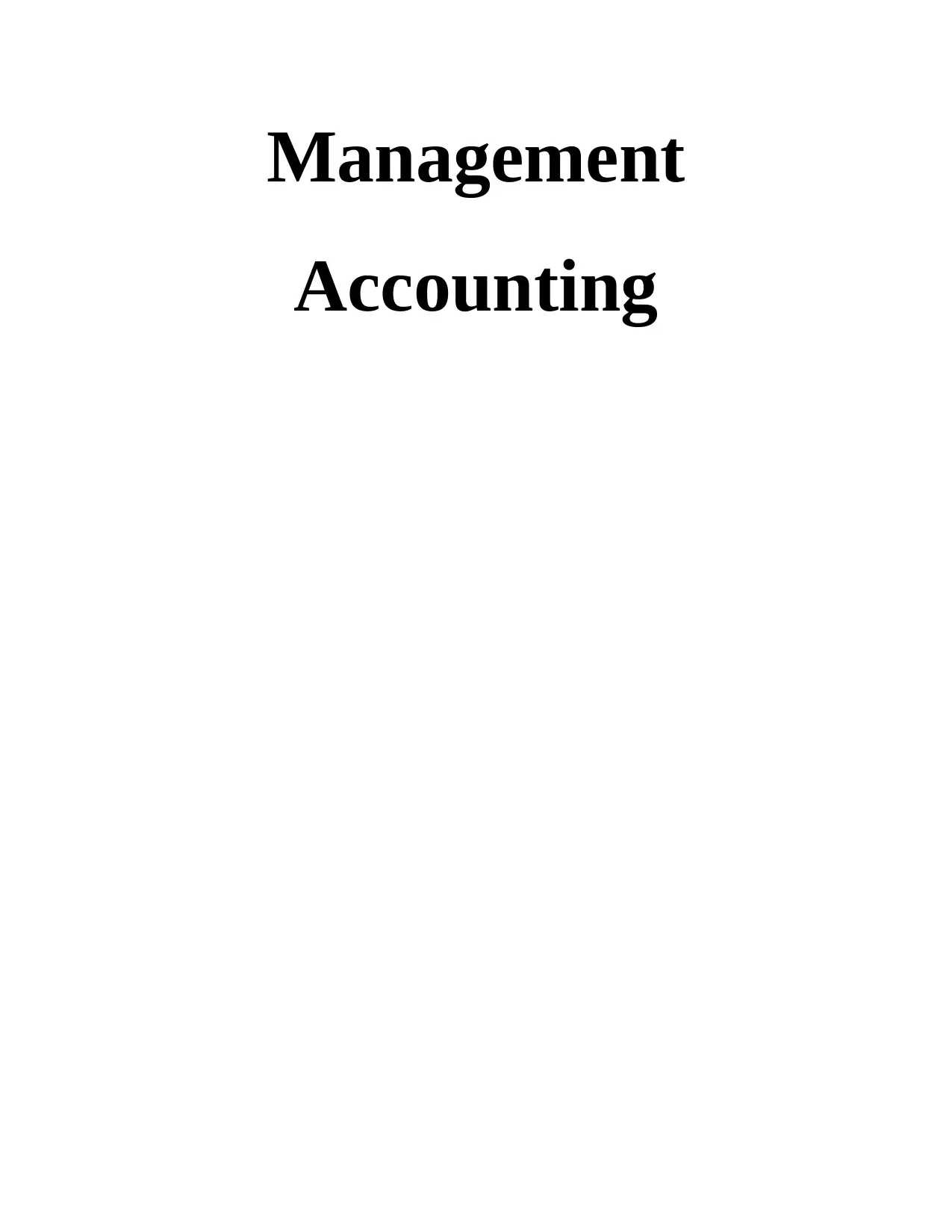
Management
Accounting
Accounting
Paraphrase This Document
Need a fresh take? Get an instant paraphrase of this document with our AI Paraphraser
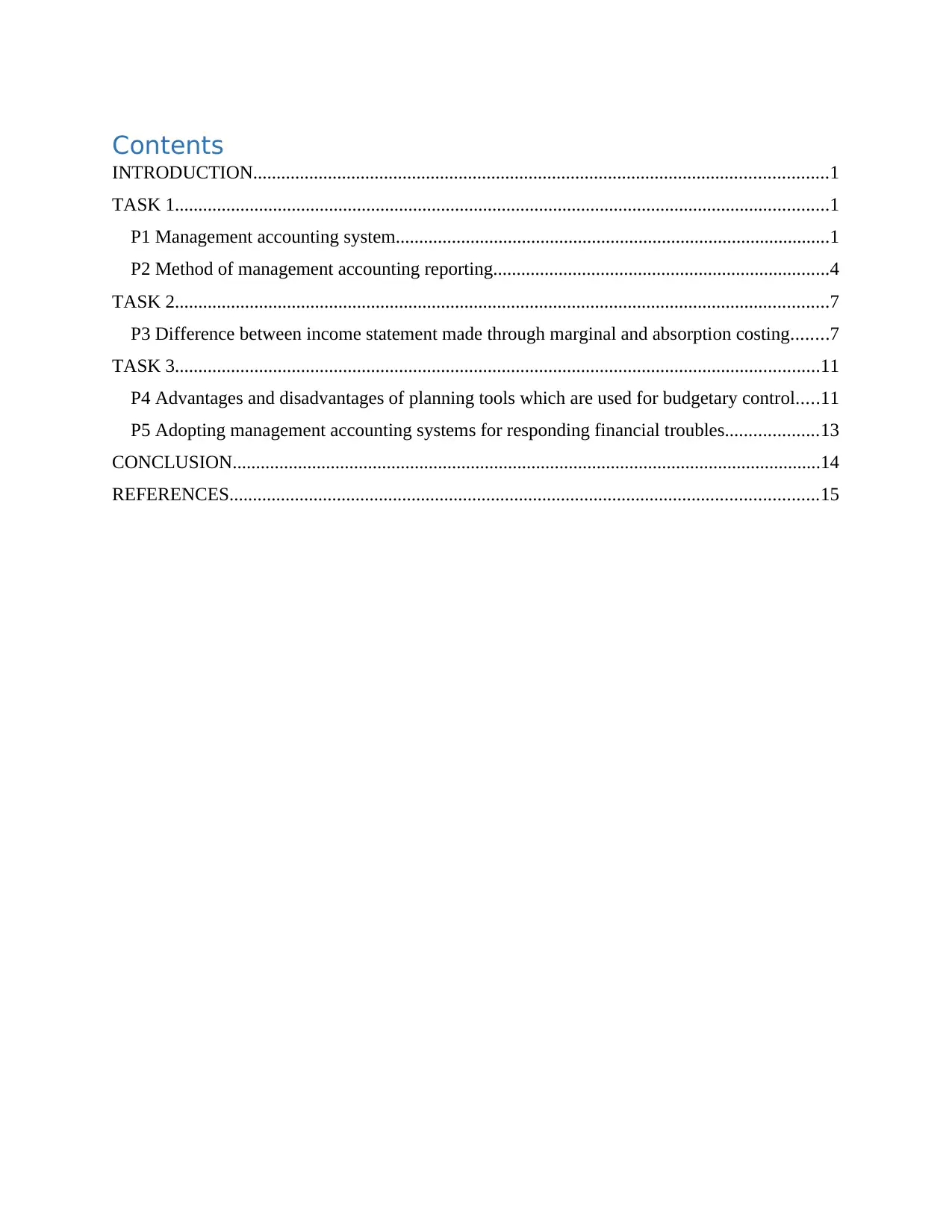
Contents
INTRODUCTION...........................................................................................................................1
TASK 1............................................................................................................................................1
P1 Management accounting system.............................................................................................1
P2 Method of management accounting reporting........................................................................4
TASK 2............................................................................................................................................7
P3 Difference between income statement made through marginal and absorption costing........7
TASK 3..........................................................................................................................................11
P4 Advantages and disadvantages of planning tools which are used for budgetary control.....11
P5 Adopting management accounting systems for responding financial troubles....................13
CONCLUSION..............................................................................................................................14
REFERENCES..............................................................................................................................15
INTRODUCTION...........................................................................................................................1
TASK 1............................................................................................................................................1
P1 Management accounting system.............................................................................................1
P2 Method of management accounting reporting........................................................................4
TASK 2............................................................................................................................................7
P3 Difference between income statement made through marginal and absorption costing........7
TASK 3..........................................................................................................................................11
P4 Advantages and disadvantages of planning tools which are used for budgetary control.....11
P5 Adopting management accounting systems for responding financial troubles....................13
CONCLUSION..............................................................................................................................14
REFERENCES..............................................................................................................................15
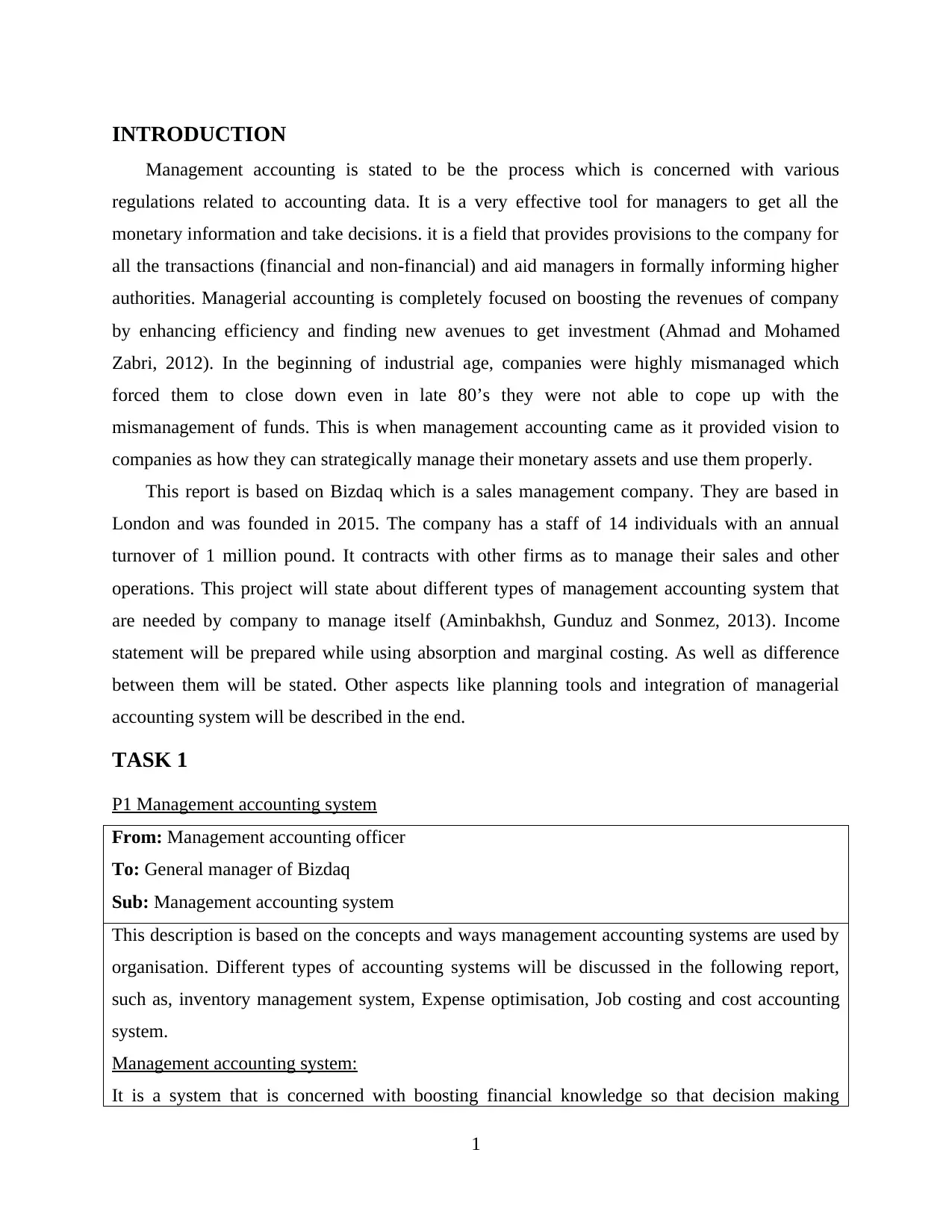
INTRODUCTION
Management accounting is stated to be the process which is concerned with various
regulations related to accounting data. It is a very effective tool for managers to get all the
monetary information and take decisions. it is a field that provides provisions to the company for
all the transactions (financial and non-financial) and aid managers in formally informing higher
authorities. Managerial accounting is completely focused on boosting the revenues of company
by enhancing efficiency and finding new avenues to get investment (Ahmad and Mohamed
Zabri, 2012). In the beginning of industrial age, companies were highly mismanaged which
forced them to close down even in late 80’s they were not able to cope up with the
mismanagement of funds. This is when management accounting came as it provided vision to
companies as how they can strategically manage their monetary assets and use them properly.
This report is based on Bizdaq which is a sales management company. They are based in
London and was founded in 2015. The company has a staff of 14 individuals with an annual
turnover of 1 million pound. It contracts with other firms as to manage their sales and other
operations. This project will state about different types of management accounting system that
are needed by company to manage itself (Aminbakhsh, Gunduz and Sonmez, 2013). Income
statement will be prepared while using absorption and marginal costing. As well as difference
between them will be stated. Other aspects like planning tools and integration of managerial
accounting system will be described in the end.
TASK 1
P1 Management accounting system
From: Management accounting officer
To: General manager of Bizdaq
Sub: Management accounting system
This description is based on the concepts and ways management accounting systems are used by
organisation. Different types of accounting systems will be discussed in the following report,
such as, inventory management system, Expense optimisation, Job costing and cost accounting
system.
Management accounting system:
It is a system that is concerned with boosting financial knowledge so that decision making
1
Management accounting is stated to be the process which is concerned with various
regulations related to accounting data. It is a very effective tool for managers to get all the
monetary information and take decisions. it is a field that provides provisions to the company for
all the transactions (financial and non-financial) and aid managers in formally informing higher
authorities. Managerial accounting is completely focused on boosting the revenues of company
by enhancing efficiency and finding new avenues to get investment (Ahmad and Mohamed
Zabri, 2012). In the beginning of industrial age, companies were highly mismanaged which
forced them to close down even in late 80’s they were not able to cope up with the
mismanagement of funds. This is when management accounting came as it provided vision to
companies as how they can strategically manage their monetary assets and use them properly.
This report is based on Bizdaq which is a sales management company. They are based in
London and was founded in 2015. The company has a staff of 14 individuals with an annual
turnover of 1 million pound. It contracts with other firms as to manage their sales and other
operations. This project will state about different types of management accounting system that
are needed by company to manage itself (Aminbakhsh, Gunduz and Sonmez, 2013). Income
statement will be prepared while using absorption and marginal costing. As well as difference
between them will be stated. Other aspects like planning tools and integration of managerial
accounting system will be described in the end.
TASK 1
P1 Management accounting system
From: Management accounting officer
To: General manager of Bizdaq
Sub: Management accounting system
This description is based on the concepts and ways management accounting systems are used by
organisation. Different types of accounting systems will be discussed in the following report,
such as, inventory management system, Expense optimisation, Job costing and cost accounting
system.
Management accounting system:
It is a system that is concerned with boosting financial knowledge so that decision making
1
⊘ This is a preview!⊘
Do you want full access?
Subscribe today to unlock all pages.

Trusted by 1+ million students worldwide
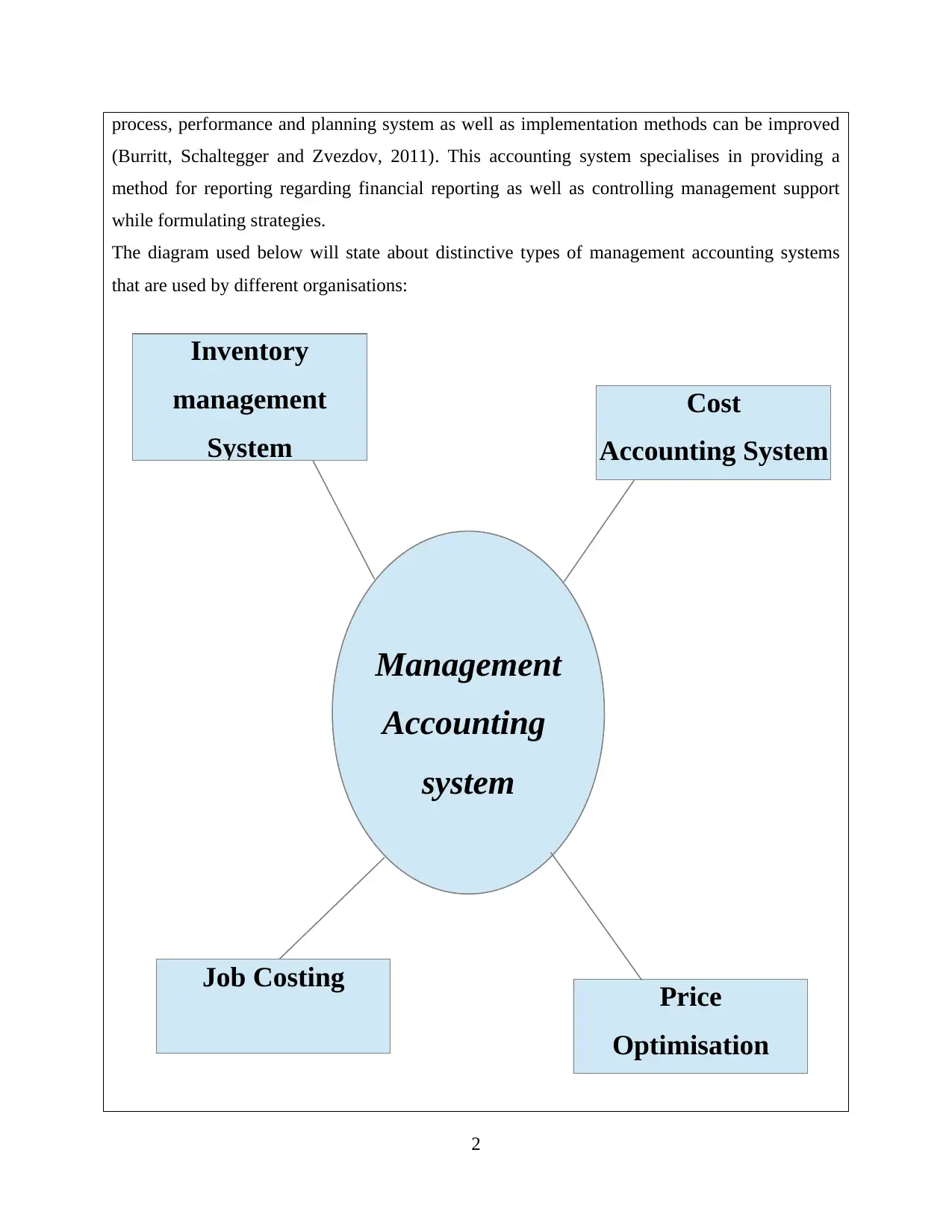
process, performance and planning system as well as implementation methods can be improved
(Burritt, Schaltegger and Zvezdov, 2011). This accounting system specialises in providing a
method for reporting regarding financial reporting as well as controlling management support
while formulating strategies.
The diagram used below will state about distinctive types of management accounting systems
that are used by different organisations:
2
Management
Accounting
system
Price
Optimisation
Job Costing
Cost
Accounting System
Inventory
management
System
(Burritt, Schaltegger and Zvezdov, 2011). This accounting system specialises in providing a
method for reporting regarding financial reporting as well as controlling management support
while formulating strategies.
The diagram used below will state about distinctive types of management accounting systems
that are used by different organisations:
2
Management
Accounting
system
Price
Optimisation
Job Costing
Cost
Accounting System
Inventory
management
System
Paraphrase This Document
Need a fresh take? Get an instant paraphrase of this document with our AI Paraphraser
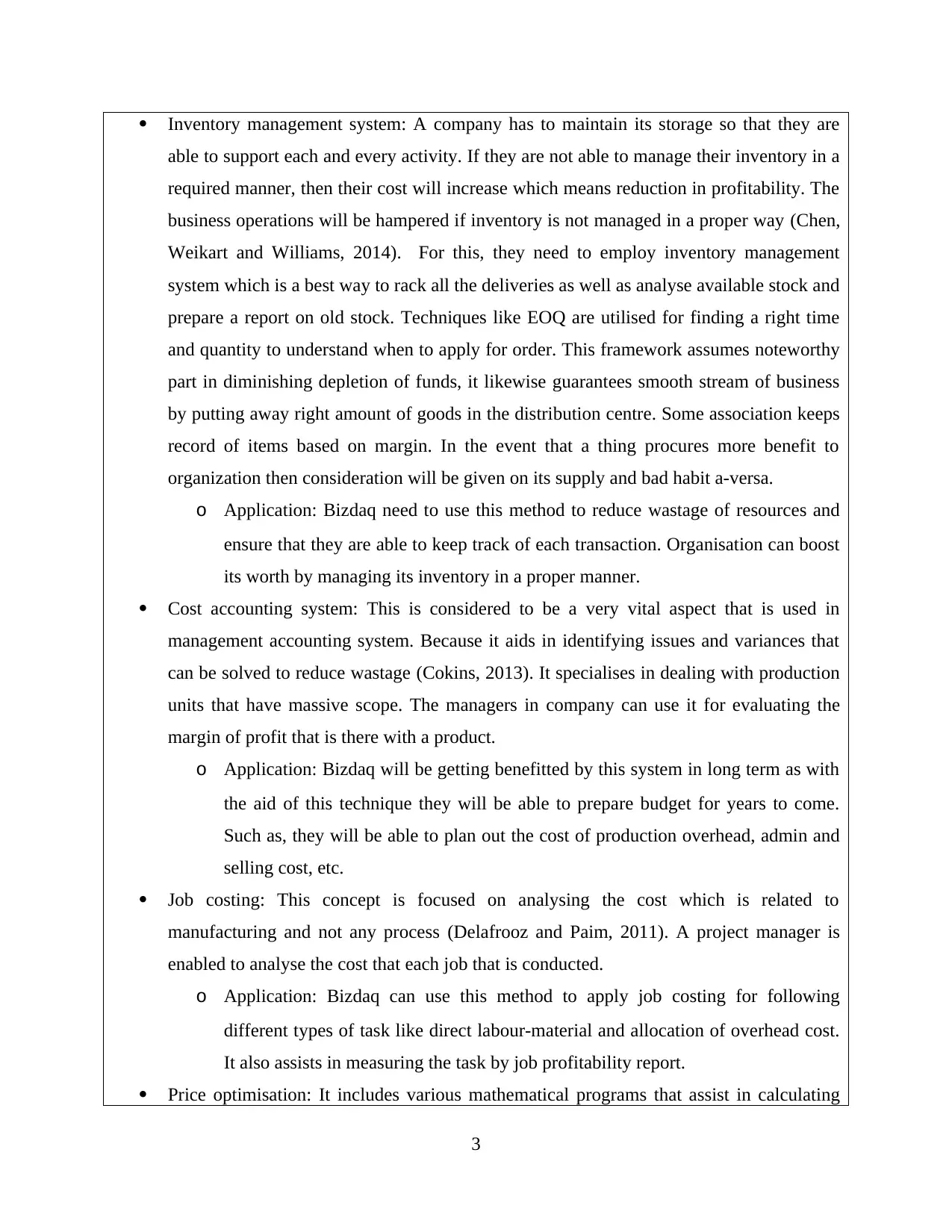
Inventory management system: A company has to maintain its storage so that they are
able to support each and every activity. If they are not able to manage their inventory in a
required manner, then their cost will increase which means reduction in profitability. The
business operations will be hampered if inventory is not managed in a proper way (Chen,
Weikart and Williams, 2014). For this, they need to employ inventory management
system which is a best way to rack all the deliveries as well as analyse available stock and
prepare a report on old stock. Techniques like EOQ are utilised for finding a right time
and quantity to understand when to apply for order. This framework assumes noteworthy
part in diminishing depletion of funds, it likewise guarantees smooth stream of business
by putting away right amount of goods in the distribution centre. Some association keeps
record of items based on margin. In the event that a thing procures more benefit to
organization then consideration will be given on its supply and bad habit a-versa.
o Application: Bizdaq need to use this method to reduce wastage of resources and
ensure that they are able to keep track of each transaction. Organisation can boost
its worth by managing its inventory in a proper manner.
Cost accounting system: This is considered to be a very vital aspect that is used in
management accounting system. Because it aids in identifying issues and variances that
can be solved to reduce wastage (Cokins, 2013). It specialises in dealing with production
units that have massive scope. The managers in company can use it for evaluating the
margin of profit that is there with a product.
o Application: Bizdaq will be getting benefitted by this system in long term as with
the aid of this technique they will be able to prepare budget for years to come.
Such as, they will be able to plan out the cost of production overhead, admin and
selling cost, etc.
Job costing: This concept is focused on analysing the cost which is related to
manufacturing and not any process (Delafrooz and Paim, 2011). A project manager is
enabled to analyse the cost that each job that is conducted.
o Application: Bizdaq can use this method to apply job costing for following
different types of task like direct labour-material and allocation of overhead cost.
It also assists in measuring the task by job profitability report.
Price optimisation: It includes various mathematical programs that assist in calculating
3
able to support each and every activity. If they are not able to manage their inventory in a
required manner, then their cost will increase which means reduction in profitability. The
business operations will be hampered if inventory is not managed in a proper way (Chen,
Weikart and Williams, 2014). For this, they need to employ inventory management
system which is a best way to rack all the deliveries as well as analyse available stock and
prepare a report on old stock. Techniques like EOQ are utilised for finding a right time
and quantity to understand when to apply for order. This framework assumes noteworthy
part in diminishing depletion of funds, it likewise guarantees smooth stream of business
by putting away right amount of goods in the distribution centre. Some association keeps
record of items based on margin. In the event that a thing procures more benefit to
organization then consideration will be given on its supply and bad habit a-versa.
o Application: Bizdaq need to use this method to reduce wastage of resources and
ensure that they are able to keep track of each transaction. Organisation can boost
its worth by managing its inventory in a proper manner.
Cost accounting system: This is considered to be a very vital aspect that is used in
management accounting system. Because it aids in identifying issues and variances that
can be solved to reduce wastage (Cokins, 2013). It specialises in dealing with production
units that have massive scope. The managers in company can use it for evaluating the
margin of profit that is there with a product.
o Application: Bizdaq will be getting benefitted by this system in long term as with
the aid of this technique they will be able to prepare budget for years to come.
Such as, they will be able to plan out the cost of production overhead, admin and
selling cost, etc.
Job costing: This concept is focused on analysing the cost which is related to
manufacturing and not any process (Delafrooz and Paim, 2011). A project manager is
enabled to analyse the cost that each job that is conducted.
o Application: Bizdaq can use this method to apply job costing for following
different types of task like direct labour-material and allocation of overhead cost.
It also assists in measuring the task by job profitability report.
Price optimisation: It includes various mathematical programs that assist in calculating
3
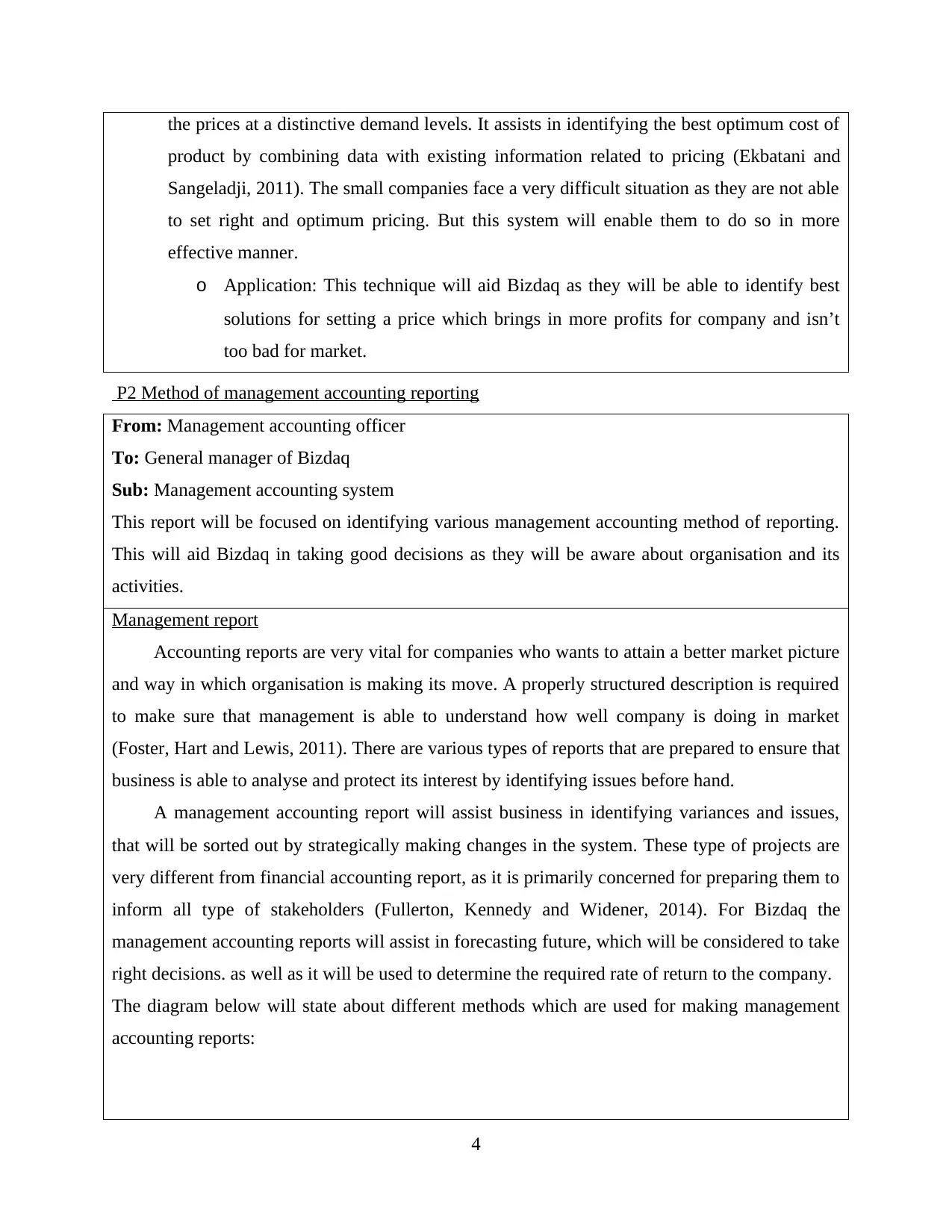
the prices at a distinctive demand levels. It assists in identifying the best optimum cost of
product by combining data with existing information related to pricing (Ekbatani and
Sangeladji, 2011). The small companies face a very difficult situation as they are not able
to set right and optimum pricing. But this system will enable them to do so in more
effective manner.
o Application: This technique will aid Bizdaq as they will be able to identify best
solutions for setting a price which brings in more profits for company and isn’t
too bad for market.
P2 Method of management accounting reporting
From: Management accounting officer
To: General manager of Bizdaq
Sub: Management accounting system
This report will be focused on identifying various management accounting method of reporting.
This will aid Bizdaq in taking good decisions as they will be aware about organisation and its
activities.
Management report
Accounting reports are very vital for companies who wants to attain a better market picture
and way in which organisation is making its move. A properly structured description is required
to make sure that management is able to understand how well company is doing in market
(Foster, Hart and Lewis, 2011). There are various types of reports that are prepared to ensure that
business is able to analyse and protect its interest by identifying issues before hand.
A management accounting report will assist business in identifying variances and issues,
that will be sorted out by strategically making changes in the system. These type of projects are
very different from financial accounting report, as it is primarily concerned for preparing them to
inform all type of stakeholders (Fullerton, Kennedy and Widener, 2014). For Bizdaq the
management accounting reports will assist in forecasting future, which will be considered to take
right decisions. as well as it will be used to determine the required rate of return to the company.
The diagram below will state about different methods which are used for making management
accounting reports:
4
product by combining data with existing information related to pricing (Ekbatani and
Sangeladji, 2011). The small companies face a very difficult situation as they are not able
to set right and optimum pricing. But this system will enable them to do so in more
effective manner.
o Application: This technique will aid Bizdaq as they will be able to identify best
solutions for setting a price which brings in more profits for company and isn’t
too bad for market.
P2 Method of management accounting reporting
From: Management accounting officer
To: General manager of Bizdaq
Sub: Management accounting system
This report will be focused on identifying various management accounting method of reporting.
This will aid Bizdaq in taking good decisions as they will be aware about organisation and its
activities.
Management report
Accounting reports are very vital for companies who wants to attain a better market picture
and way in which organisation is making its move. A properly structured description is required
to make sure that management is able to understand how well company is doing in market
(Foster, Hart and Lewis, 2011). There are various types of reports that are prepared to ensure that
business is able to analyse and protect its interest by identifying issues before hand.
A management accounting report will assist business in identifying variances and issues,
that will be sorted out by strategically making changes in the system. These type of projects are
very different from financial accounting report, as it is primarily concerned for preparing them to
inform all type of stakeholders (Fullerton, Kennedy and Widener, 2014). For Bizdaq the
management accounting reports will assist in forecasting future, which will be considered to take
right decisions. as well as it will be used to determine the required rate of return to the company.
The diagram below will state about different methods which are used for making management
accounting reports:
4
⊘ This is a preview!⊘
Do you want full access?
Subscribe today to unlock all pages.

Trusted by 1+ million students worldwide

Budget report: This is a type which is used by organisation to identify performance. This
is an internal report which is used by managers to compare between actual and current
performance so that they can identify variances. Basically, it is designed to compare
between actual and standards achievements so that they are able to understand to which
level they have improved.
Most of the times financial goals are the one which are based on budget estimates as well as
future forecast. There are times when they are wrong as real financial performance can fluctuate
(Gaizauskas and Martinavicius, 2013). Ultimately, managers use the estimated budget numbers
that were set as a standard in the beginning of task. Bizdaq can use budget report for determining
fluctuations that exist in between actual and estimated figures. Higher level of variation will
mean that company failed in controlling its resources as well as they over used them that
increased the cost for the firm. For example, Bizdaq has a standard sale of 450 while they sold
600 units in a set time frame. With this it can be stated that they are under budgeted.
Accounts receivable aging report: This is a type of report is stated to be periodic in nature
as it received organisation account in a set time frame which is considered to be invoice
outstanding. It is used for ensuring that financial condition of firm is maintained. If the
5
Methods of Management Accounting Report
Inventory reports
Budget Report
Job costs Reports
Cash flow report
Income statement
report
Accounts receivable
Aging Report
is an internal report which is used by managers to compare between actual and current
performance so that they can identify variances. Basically, it is designed to compare
between actual and standards achievements so that they are able to understand to which
level they have improved.
Most of the times financial goals are the one which are based on budget estimates as well as
future forecast. There are times when they are wrong as real financial performance can fluctuate
(Gaizauskas and Martinavicius, 2013). Ultimately, managers use the estimated budget numbers
that were set as a standard in the beginning of task. Bizdaq can use budget report for determining
fluctuations that exist in between actual and estimated figures. Higher level of variation will
mean that company failed in controlling its resources as well as they over used them that
increased the cost for the firm. For example, Bizdaq has a standard sale of 450 while they sold
600 units in a set time frame. With this it can be stated that they are under budgeted.
Accounts receivable aging report: This is a type of report is stated to be periodic in nature
as it received organisation account in a set time frame which is considered to be invoice
outstanding. It is used for ensuring that financial condition of firm is maintained. If the
5
Methods of Management Accounting Report
Inventory reports
Budget Report
Job costs Reports
Cash flow report
Income statement
report
Accounts receivable
Aging Report
Paraphrase This Document
Need a fresh take? Get an instant paraphrase of this document with our AI Paraphraser
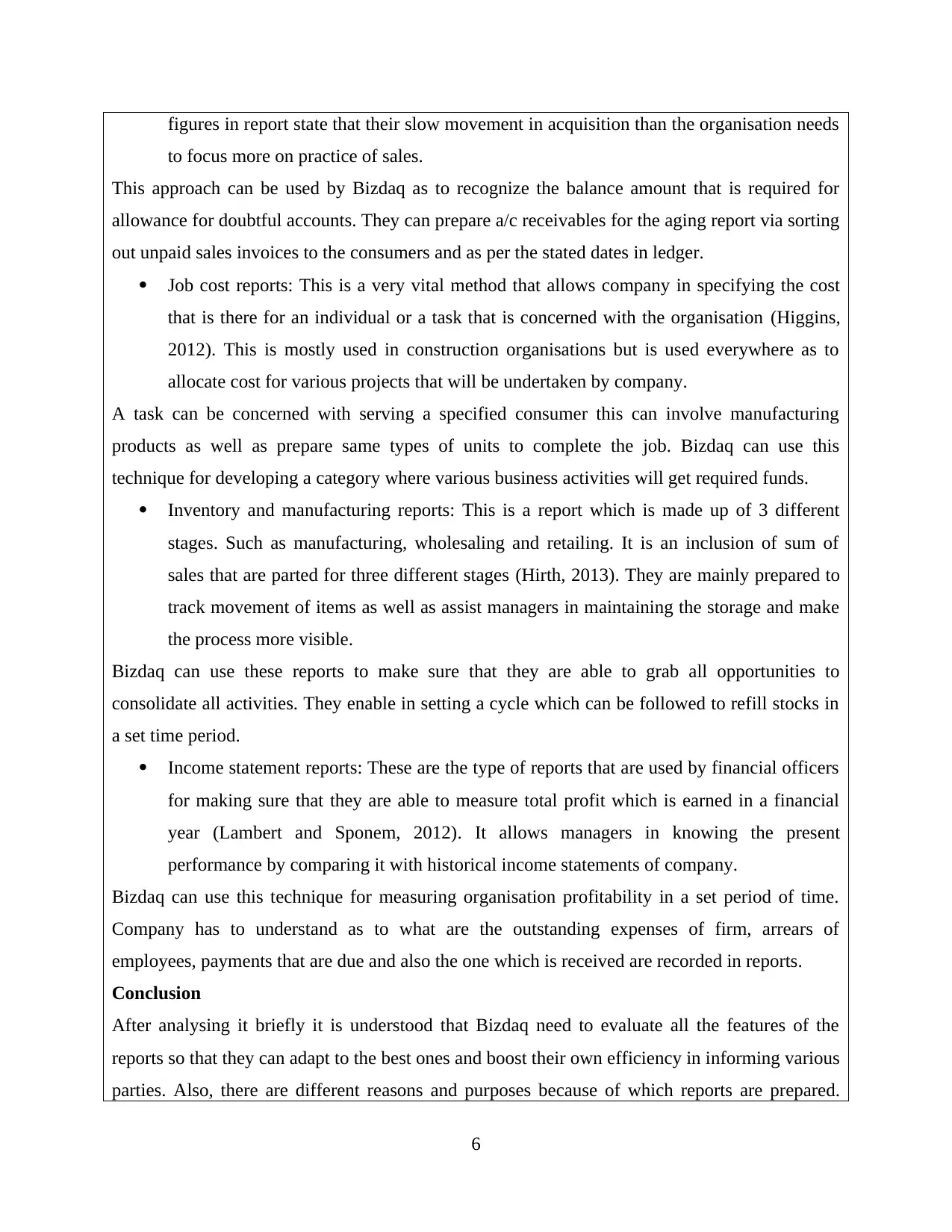
figures in report state that their slow movement in acquisition than the organisation needs
to focus more on practice of sales.
This approach can be used by Bizdaq as to recognize the balance amount that is required for
allowance for doubtful accounts. They can prepare a/c receivables for the aging report via sorting
out unpaid sales invoices to the consumers and as per the stated dates in ledger.
Job cost reports: This is a very vital method that allows company in specifying the cost
that is there for an individual or a task that is concerned with the organisation (Higgins,
2012). This is mostly used in construction organisations but is used everywhere as to
allocate cost for various projects that will be undertaken by company.
A task can be concerned with serving a specified consumer this can involve manufacturing
products as well as prepare same types of units to complete the job. Bizdaq can use this
technique for developing a category where various business activities will get required funds.
Inventory and manufacturing reports: This is a report which is made up of 3 different
stages. Such as manufacturing, wholesaling and retailing. It is an inclusion of sum of
sales that are parted for three different stages (Hirth, 2013). They are mainly prepared to
track movement of items as well as assist managers in maintaining the storage and make
the process more visible.
Bizdaq can use these reports to make sure that they are able to grab all opportunities to
consolidate all activities. They enable in setting a cycle which can be followed to refill stocks in
a set time period.
Income statement reports: These are the type of reports that are used by financial officers
for making sure that they are able to measure total profit which is earned in a financial
year (Lambert and Sponem, 2012). It allows managers in knowing the present
performance by comparing it with historical income statements of company.
Bizdaq can use this technique for measuring organisation profitability in a set period of time.
Company has to understand as to what are the outstanding expenses of firm, arrears of
employees, payments that are due and also the one which is received are recorded in reports.
Conclusion
After analysing it briefly it is understood that Bizdaq need to evaluate all the features of the
reports so that they can adapt to the best ones and boost their own efficiency in informing various
parties. Also, there are different reasons and purposes because of which reports are prepared.
6
to focus more on practice of sales.
This approach can be used by Bizdaq as to recognize the balance amount that is required for
allowance for doubtful accounts. They can prepare a/c receivables for the aging report via sorting
out unpaid sales invoices to the consumers and as per the stated dates in ledger.
Job cost reports: This is a very vital method that allows company in specifying the cost
that is there for an individual or a task that is concerned with the organisation (Higgins,
2012). This is mostly used in construction organisations but is used everywhere as to
allocate cost for various projects that will be undertaken by company.
A task can be concerned with serving a specified consumer this can involve manufacturing
products as well as prepare same types of units to complete the job. Bizdaq can use this
technique for developing a category where various business activities will get required funds.
Inventory and manufacturing reports: This is a report which is made up of 3 different
stages. Such as manufacturing, wholesaling and retailing. It is an inclusion of sum of
sales that are parted for three different stages (Hirth, 2013). They are mainly prepared to
track movement of items as well as assist managers in maintaining the storage and make
the process more visible.
Bizdaq can use these reports to make sure that they are able to grab all opportunities to
consolidate all activities. They enable in setting a cycle which can be followed to refill stocks in
a set time period.
Income statement reports: These are the type of reports that are used by financial officers
for making sure that they are able to measure total profit which is earned in a financial
year (Lambert and Sponem, 2012). It allows managers in knowing the present
performance by comparing it with historical income statements of company.
Bizdaq can use this technique for measuring organisation profitability in a set period of time.
Company has to understand as to what are the outstanding expenses of firm, arrears of
employees, payments that are due and also the one which is received are recorded in reports.
Conclusion
After analysing it briefly it is understood that Bizdaq need to evaluate all the features of the
reports so that they can adapt to the best ones and boost their own efficiency in informing various
parties. Also, there are different reasons and purposes because of which reports are prepared.
6
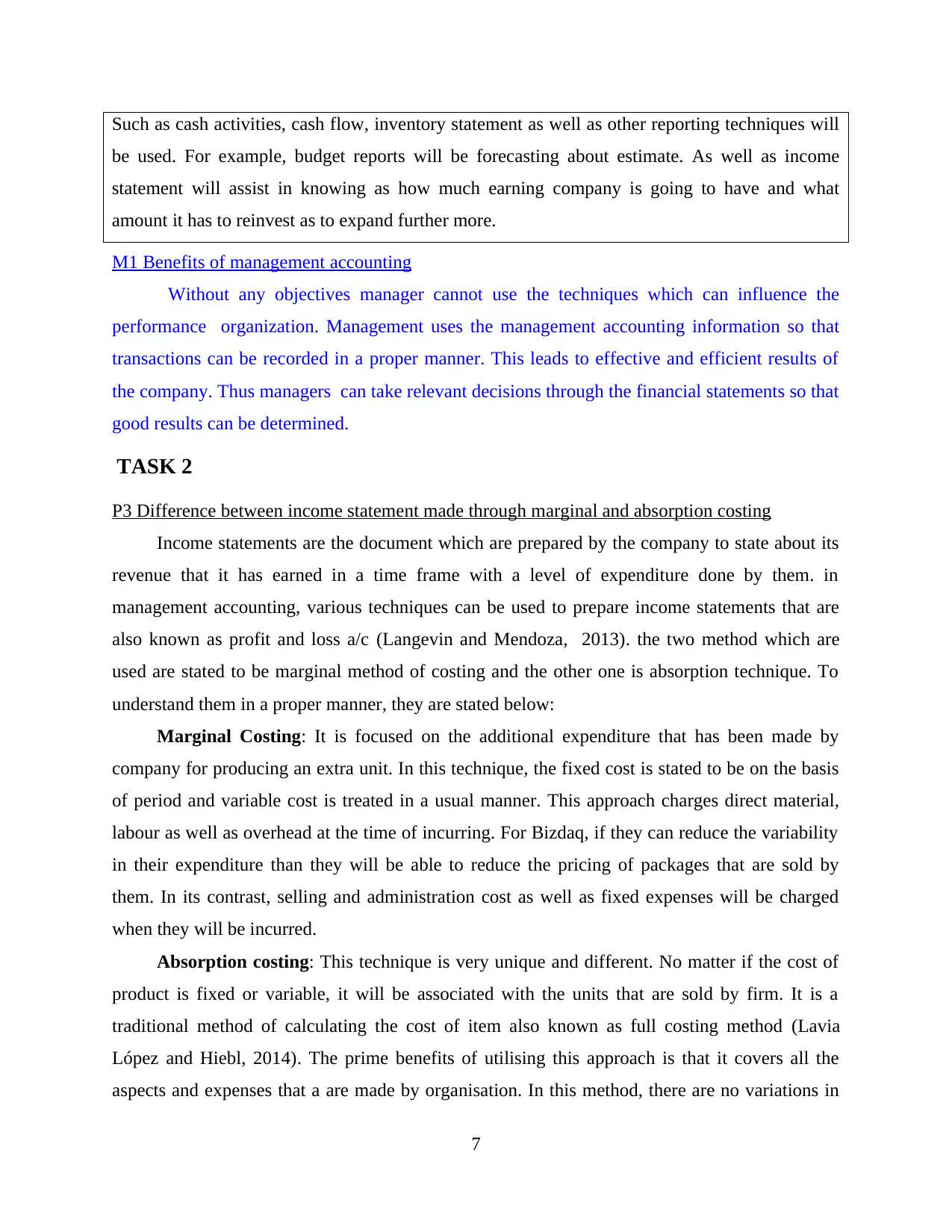
Such as cash activities, cash flow, inventory statement as well as other reporting techniques will
be used. For example, budget reports will be forecasting about estimate. As well as income
statement will assist in knowing as how much earning company is going to have and what
amount it has to reinvest as to expand further more.
M1 Benefits of management accounting
Without any objectives manager cannot use the techniques which can influence the
performance organization. Management uses the management accounting information so that
transactions can be recorded in a proper manner. This leads to effective and efficient results of
the company. Thus managers can take relevant decisions through the financial statements so that
good results can be determined.
TASK 2
P3 Difference between income statement made through marginal and absorption costing
Income statements are the document which are prepared by the company to state about its
revenue that it has earned in a time frame with a level of expenditure done by them. in
management accounting, various techniques can be used to prepare income statements that are
also known as profit and loss a/c (Langevin and Mendoza, 2013). the two method which are
used are stated to be marginal method of costing and the other one is absorption technique. To
understand them in a proper manner, they are stated below:
Marginal Costing: It is focused on the additional expenditure that has been made by
company for producing an extra unit. In this technique, the fixed cost is stated to be on the basis
of period and variable cost is treated in a usual manner. This approach charges direct material,
labour as well as overhead at the time of incurring. For Bizdaq, if they can reduce the variability
in their expenditure than they will be able to reduce the pricing of packages that are sold by
them. In its contrast, selling and administration cost as well as fixed expenses will be charged
when they will be incurred.
Absorption costing: This technique is very unique and different. No matter if the cost of
product is fixed or variable, it will be associated with the units that are sold by firm. It is a
traditional method of calculating the cost of item also known as full costing method (Lavia
López and Hiebl, 2014). The prime benefits of utilising this approach is that it covers all the
aspects and expenses that a are made by organisation. In this method, there are no variations in
7
be used. For example, budget reports will be forecasting about estimate. As well as income
statement will assist in knowing as how much earning company is going to have and what
amount it has to reinvest as to expand further more.
M1 Benefits of management accounting
Without any objectives manager cannot use the techniques which can influence the
performance organization. Management uses the management accounting information so that
transactions can be recorded in a proper manner. This leads to effective and efficient results of
the company. Thus managers can take relevant decisions through the financial statements so that
good results can be determined.
TASK 2
P3 Difference between income statement made through marginal and absorption costing
Income statements are the document which are prepared by the company to state about its
revenue that it has earned in a time frame with a level of expenditure done by them. in
management accounting, various techniques can be used to prepare income statements that are
also known as profit and loss a/c (Langevin and Mendoza, 2013). the two method which are
used are stated to be marginal method of costing and the other one is absorption technique. To
understand them in a proper manner, they are stated below:
Marginal Costing: It is focused on the additional expenditure that has been made by
company for producing an extra unit. In this technique, the fixed cost is stated to be on the basis
of period and variable cost is treated in a usual manner. This approach charges direct material,
labour as well as overhead at the time of incurring. For Bizdaq, if they can reduce the variability
in their expenditure than they will be able to reduce the pricing of packages that are sold by
them. In its contrast, selling and administration cost as well as fixed expenses will be charged
when they will be incurred.
Absorption costing: This technique is very unique and different. No matter if the cost of
product is fixed or variable, it will be associated with the units that are sold by firm. It is a
traditional method of calculating the cost of item also known as full costing method (Lavia
López and Hiebl, 2014). The prime benefits of utilising this approach is that it covers all the
aspects and expenses that a are made by organisation. In this method, there are no variations in
7
⊘ This is a preview!⊘
Do you want full access?
Subscribe today to unlock all pages.

Trusted by 1+ million students worldwide
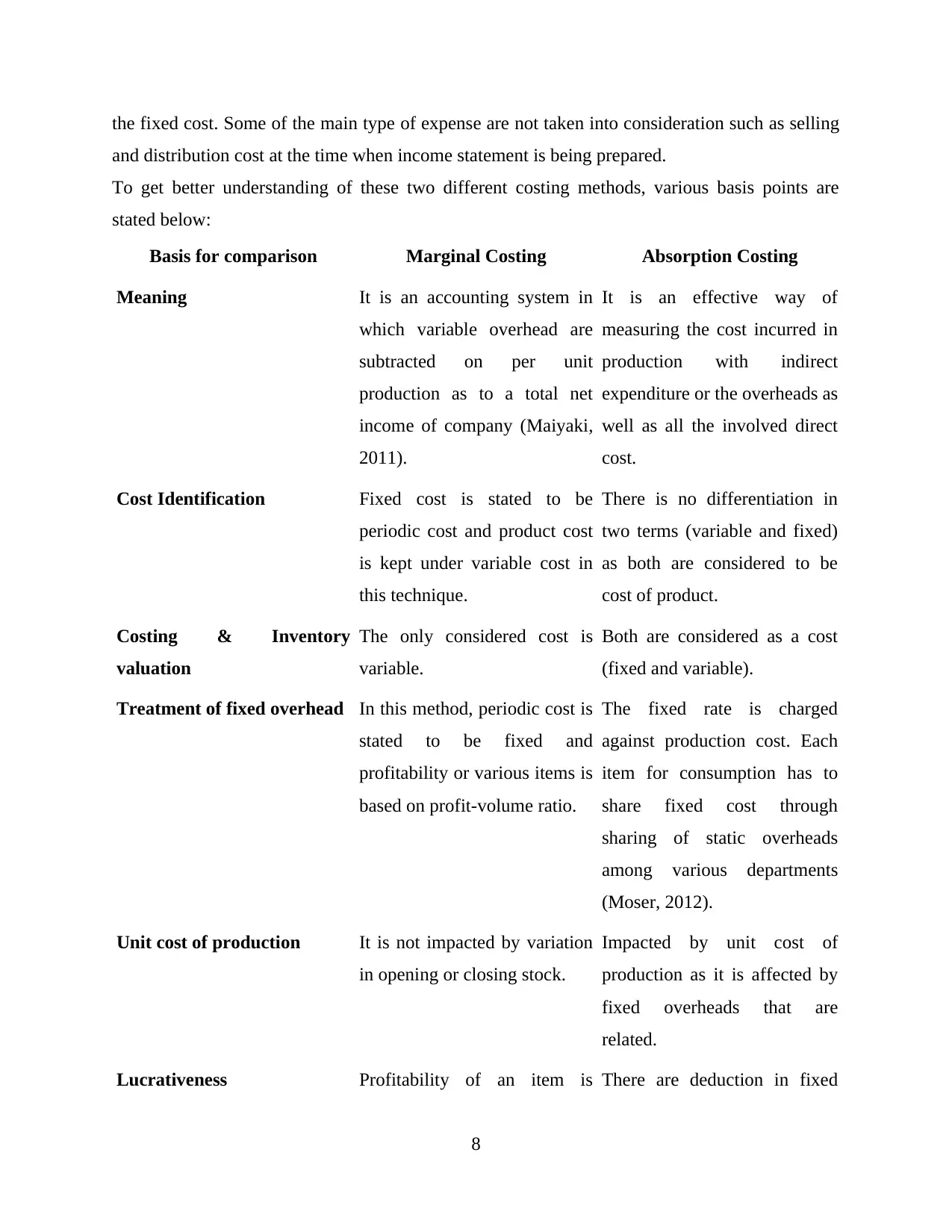
the fixed cost. Some of the main type of expense are not taken into consideration such as selling
and distribution cost at the time when income statement is being prepared.
To get better understanding of these two different costing methods, various basis points are
stated below:
Basis for comparison Marginal Costing Absorption Costing
Meaning It is an accounting system in
which variable overhead are
subtracted on per unit
production as to a total net
income of company (Maiyaki,
2011).
It is an effective way of
measuring the cost incurred in
production with indirect
expenditure or the overheads as
well as all the involved direct
cost.
Cost Identification Fixed cost is stated to be
periodic cost and product cost
is kept under variable cost in
this technique.
There is no differentiation in
two terms (variable and fixed)
as both are considered to be
cost of product.
Costing & Inventory
valuation
The only considered cost is
variable.
Both are considered as a cost
(fixed and variable).
Treatment of fixed overhead In this method, periodic cost is
stated to be fixed and
profitability or various items is
based on profit-volume ratio.
The fixed rate is charged
against production cost. Each
item for consumption has to
share fixed cost through
sharing of static overheads
among various departments
(Moser, 2012).
Unit cost of production It is not impacted by variation
in opening or closing stock.
Impacted by unit cost of
production as it is affected by
fixed overheads that are
related.
Lucrativeness Profitability of an item is There are deduction in fixed
8
and distribution cost at the time when income statement is being prepared.
To get better understanding of these two different costing methods, various basis points are
stated below:
Basis for comparison Marginal Costing Absorption Costing
Meaning It is an accounting system in
which variable overhead are
subtracted on per unit
production as to a total net
income of company (Maiyaki,
2011).
It is an effective way of
measuring the cost incurred in
production with indirect
expenditure or the overheads as
well as all the involved direct
cost.
Cost Identification Fixed cost is stated to be
periodic cost and product cost
is kept under variable cost in
this technique.
There is no differentiation in
two terms (variable and fixed)
as both are considered to be
cost of product.
Costing & Inventory
valuation
The only considered cost is
variable.
Both are considered as a cost
(fixed and variable).
Treatment of fixed overhead In this method, periodic cost is
stated to be fixed and
profitability or various items is
based on profit-volume ratio.
The fixed rate is charged
against production cost. Each
item for consumption has to
share fixed cost through
sharing of static overheads
among various departments
(Moser, 2012).
Unit cost of production It is not impacted by variation
in opening or closing stock.
Impacted by unit cost of
production as it is affected by
fixed overheads that are
related.
Lucrativeness Profitability of an item is There are deduction in fixed
8
Paraphrase This Document
Need a fresh take? Get an instant paraphrase of this document with our AI Paraphraser
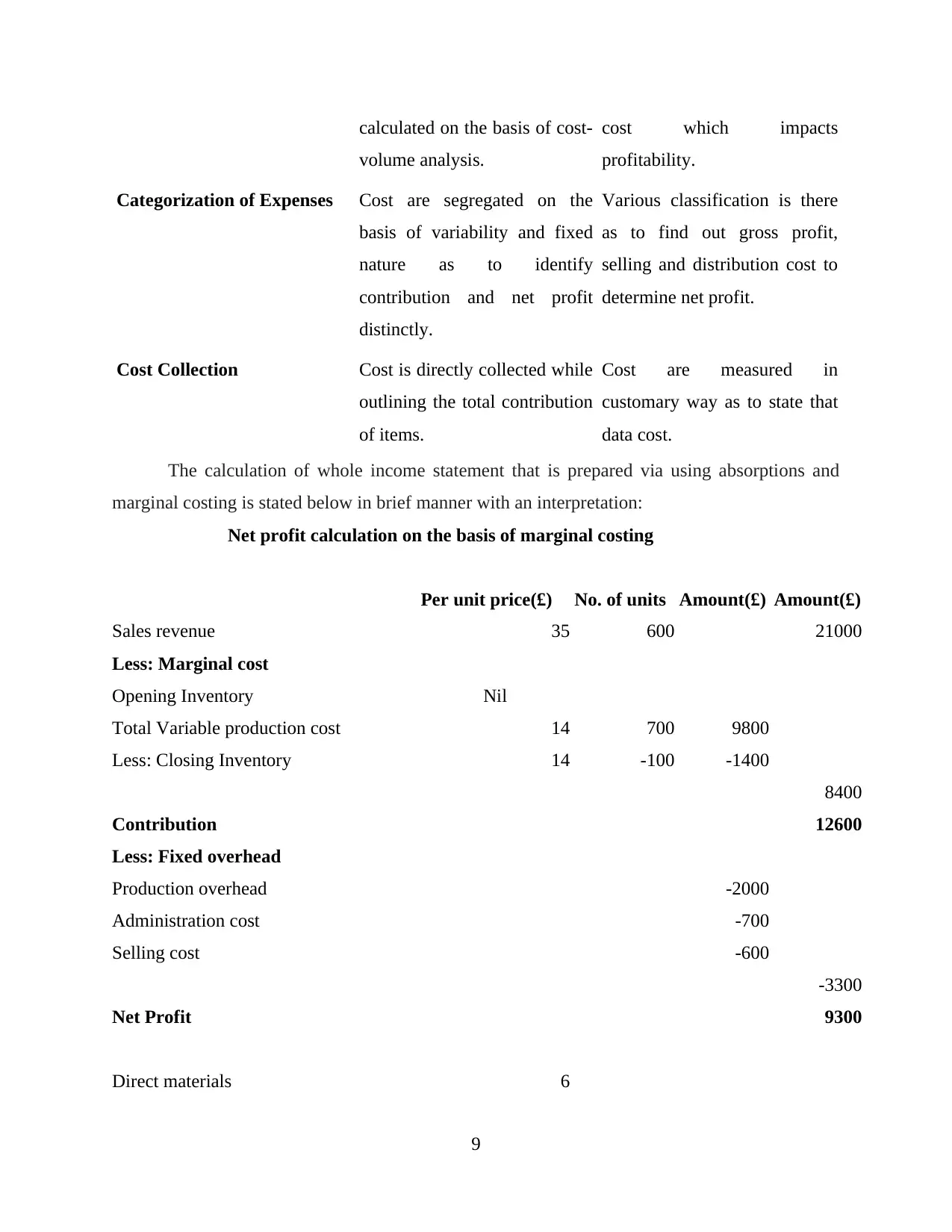
calculated on the basis of cost-
volume analysis.
cost which impacts
profitability.
Categorization of Expenses Cost are segregated on the
basis of variability and fixed
nature as to identify
contribution and net profit
distinctly.
Various classification is there
as to find out gross profit,
selling and distribution cost to
determine net profit.
Cost Collection Cost is directly collected while
outlining the total contribution
of items.
Cost are measured in
customary way as to state that
data cost.
The calculation of whole income statement that is prepared via using absorptions and
marginal costing is stated below in brief manner with an interpretation:
Net profit calculation on the basis of marginal costing
Per unit price(£) No. of units Amount(£) Amount(£)
Sales revenue 35 600 21000
Less: Marginal cost
Opening Inventory Nil
Total Variable production cost 14 700 9800
Less: Closing Inventory 14 -100 -1400
8400
Contribution 12600
Less: Fixed overhead
Production overhead -2000
Administration cost -700
Selling cost -600
-3300
Net Profit 9300
Direct materials 6
9
volume analysis.
cost which impacts
profitability.
Categorization of Expenses Cost are segregated on the
basis of variability and fixed
nature as to identify
contribution and net profit
distinctly.
Various classification is there
as to find out gross profit,
selling and distribution cost to
determine net profit.
Cost Collection Cost is directly collected while
outlining the total contribution
of items.
Cost are measured in
customary way as to state that
data cost.
The calculation of whole income statement that is prepared via using absorptions and
marginal costing is stated below in brief manner with an interpretation:
Net profit calculation on the basis of marginal costing
Per unit price(£) No. of units Amount(£) Amount(£)
Sales revenue 35 600 21000
Less: Marginal cost
Opening Inventory Nil
Total Variable production cost 14 700 9800
Less: Closing Inventory 14 -100 -1400
8400
Contribution 12600
Less: Fixed overhead
Production overhead -2000
Administration cost -700
Selling cost -600
-3300
Net Profit 9300
Direct materials 6
9
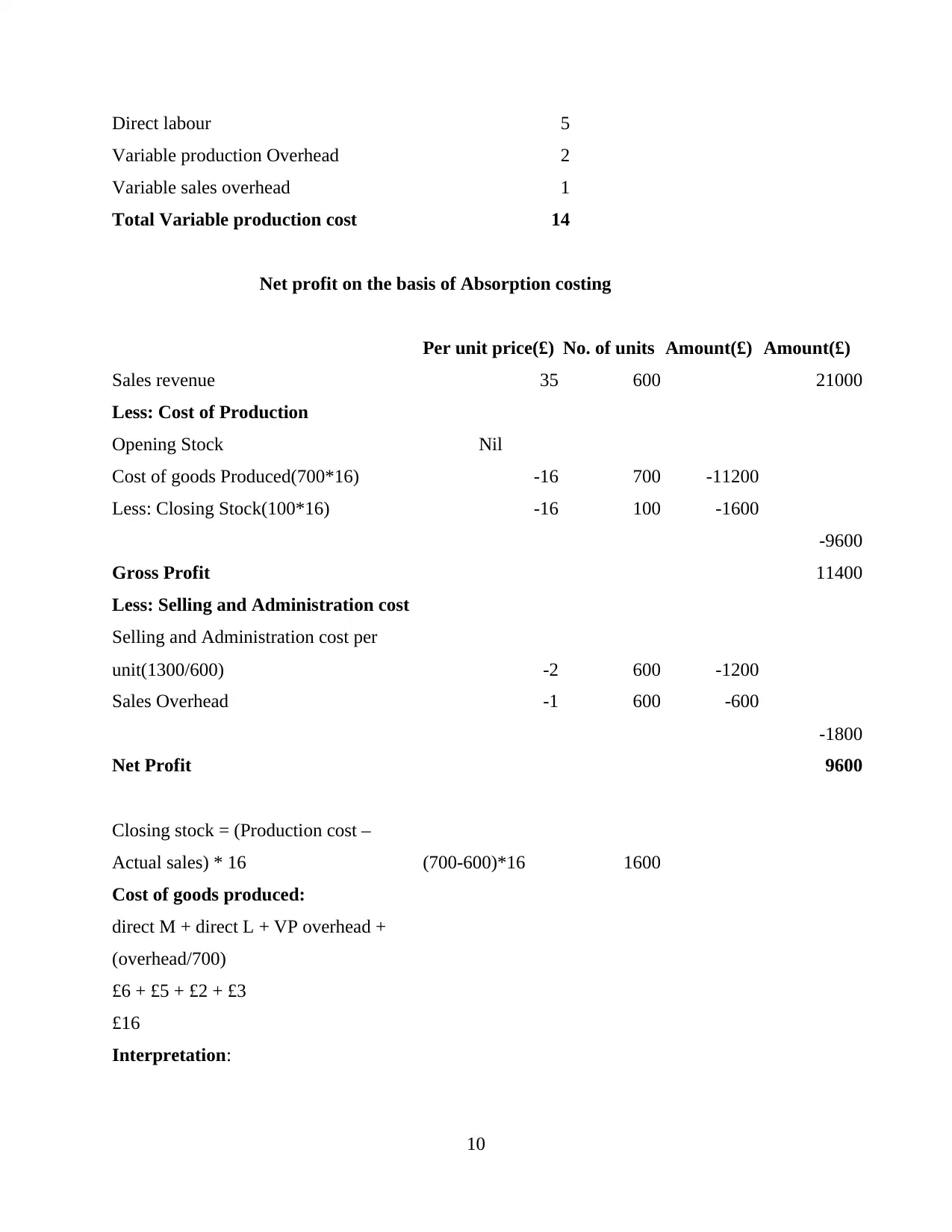
Direct labour 5
Variable production Overhead 2
Variable sales overhead 1
Total Variable production cost 14
Net profit on the basis of Absorption costing
Per unit price(£) No. of units Amount(£) Amount(£)
Sales revenue 35 600 21000
Less: Cost of Production
Opening Stock Nil
Cost of goods Produced(700*16) -16 700 -11200
Less: Closing Stock(100*16) -16 100 -1600
-9600
Gross Profit 11400
Less: Selling and Administration cost
Selling and Administration cost per
unit(1300/600) -2 600 -1200
Sales Overhead -1 600 -600
-1800
Net Profit 9600
Closing stock = (Production cost –
Actual sales) * 16 (700-600)*16 1600
Cost of goods produced:
direct M + direct L + VP overhead +
(overhead/700)
£6 + £5 + £2 + £3
£16
Interpretation:
10
Variable production Overhead 2
Variable sales overhead 1
Total Variable production cost 14
Net profit on the basis of Absorption costing
Per unit price(£) No. of units Amount(£) Amount(£)
Sales revenue 35 600 21000
Less: Cost of Production
Opening Stock Nil
Cost of goods Produced(700*16) -16 700 -11200
Less: Closing Stock(100*16) -16 100 -1600
-9600
Gross Profit 11400
Less: Selling and Administration cost
Selling and Administration cost per
unit(1300/600) -2 600 -1200
Sales Overhead -1 600 -600
-1800
Net Profit 9600
Closing stock = (Production cost –
Actual sales) * 16 (700-600)*16 1600
Cost of goods produced:
direct M + direct L + VP overhead +
(overhead/700)
£6 + £5 + £2 + £3
£16
Interpretation:
10
⊘ This is a preview!⊘
Do you want full access?
Subscribe today to unlock all pages.

Trusted by 1+ million students worldwide
1 out of 18
Related Documents
Your All-in-One AI-Powered Toolkit for Academic Success.
+13062052269
info@desklib.com
Available 24*7 on WhatsApp / Email
![[object Object]](/_next/static/media/star-bottom.7253800d.svg)
Unlock your academic potential
Copyright © 2020–2025 A2Z Services. All Rights Reserved. Developed and managed by ZUCOL.





